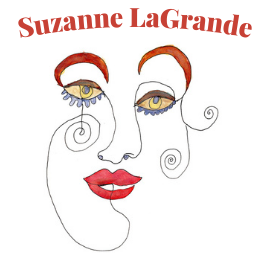15 A Woman of Independent Means
Hilma af Klint, small in stature and curious by nature, possessed a lively mind.
Like her father, she was interested mathematics and music, and from summers spent in Adelso, an island in Lake Malaren, she developed a life-long fascination with nature and natural forms.
Though she did not come from a family of artists, her family recognized her artistic talents and in 1862, when Hilma was twenty, they allowed her enroll at the Royal Academy of Fine Arts in Stockholm. She was part of the second class of women in Sweden’s history to be admitted.
I study a black and white photograph photograph, a formal studio portrait when she was a young woman, around the time she entered the Royal Academy. As was the style in the 1800s, her hair is pulled back into a bun on the crest of her head and she wears blouse with a high collar, sleeves puffed at the shoulders, a square brooch pinned to the base of her throat. She does not look at into the camera, her gaze intent upon the future still before her.
At the Royal Academy, Hilma dedicated herself to studying landscape painting and portraiture, and excelled at both.
As Luciana Pinheiro in Colors of the Soul writes, “Her landscapes were vivid and faithful to original color ranges — technically speaking, well developed. Her botanical watercolor studies, dating from 1880 to 1890, bore testament to her precise observation of nature.”
The Colors Of The Soul - The Life Of Hilma Af Klint - Luciana Pinheiro | HotmartIn 1944, stored in an attic on the outskirts of Stockholm, 124 diaries and more than 1200 paintings. It was the work of…www.hotmart.com
While both women and men received the same training from the same teachers at the Royal Academy, they studied in separate classes. In the prevailing sexist views of the day, women artists were viewed as technicians learning a skilled trade, not artistic innovators.
At the academy Hilma met Anna Casell, also a talented landscape painter, who shared Hilma’s strong sense of ethics and a passion for freedom. Anna chose not to marry because marriage would mean losing her freedom
Hilma, also choose not to marry, but unlike Anna, who came from a wealthy family, the prestige of the royal title “af” in af Klint did not guarantee her a significant income.
When she graduated with honors, Hilma was awarded a scholarship in the form of shared studio space in the same building that housed Blanch’s Café and Blanch’s Art Gallery. The cafe with its crystal comfortable chairs, selection of foreign newspapers and live music was at the center of artistic and cultural life in Stockholm.
She supported herself as painter, doing landscapes, botanical drawings, and portraits. commissioned by aristocrats of the day.

